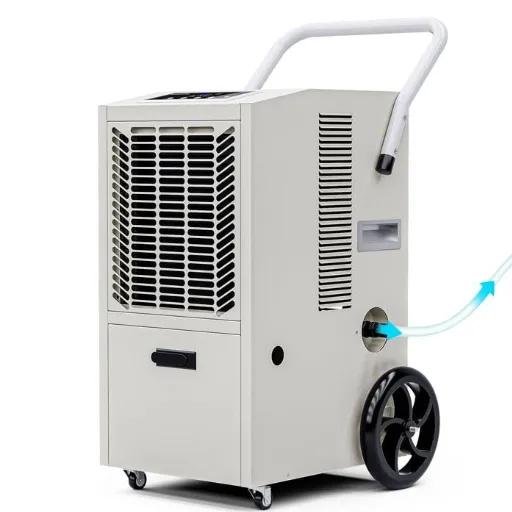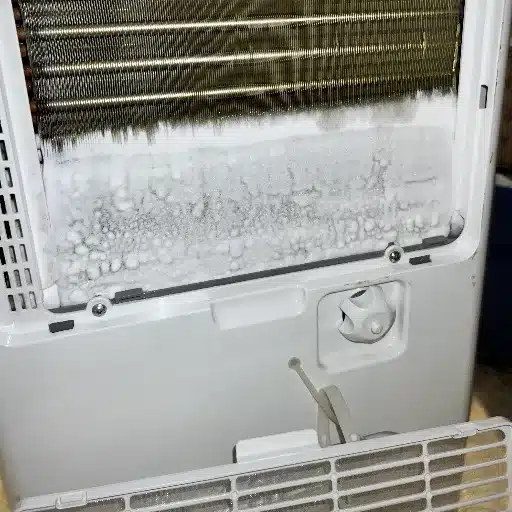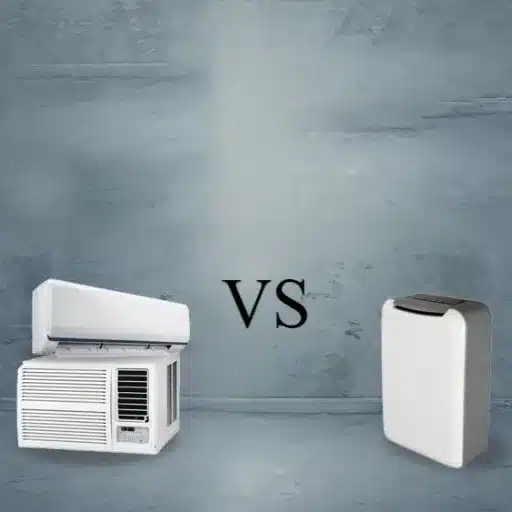Essential Guide: Controlling humidity in your bathroom is crucial for preventing mold growth, structural damage, and maintaining a healthy environment. This comprehensive guide explores the most effective dehumidification solutions, from compact portable units to smart systems, helping you choose the perfect moisture control solution for your space.
Understanding Humidity in Your Bathroom
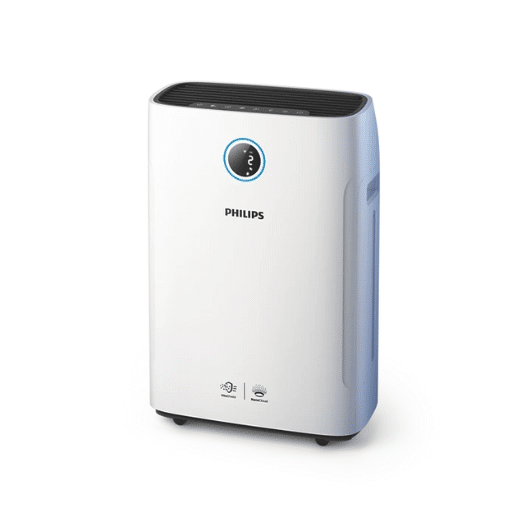
Most bathroom humidity occurs due to steam from bathing and showering, combined with poor ventilation. This situation promotes condensation, which encourages mold and mildew growth and causes surface damage. Effective humidity control involves maintaining proper airflow through exhaust fans or windows, removing wet surfaces promptly, and using a dehumidifier for bathroom applications along with moisture-resistant materials and fixtures.
What Causes High Humidity in Bathrooms?
Bathrooms experience high humidity levels due to moisture from daily activities like showering, bathing, and washing with warm water. Steam production from hot water increases water vapor concentration in the air. This problem worsens without proper ventilation systems like exhaust fans or windows.
Key Factors Contributing to Bathroom Humidity:
- Hot water steam from showers and baths
- Inadequate ventilation systems
- External moisture infiltration through porous materials
- Plumbing leaks and inefficient sealing
- Poor air circulation patterns
Effects of Excess Moisture on Bathroom Environment
Excessive moisture creates significant structural and health impacts. High humidity enables mold growth on walls, ceilings, grout, and surfaces, potentially harming people with respiratory conditions or allergies. Extended exposure to wet environments gradually destroys construction elements like wood and drywall, making replacement necessary over time.
| Problem | Causes | Consequences |
|---|---|---|
| Mold & Mildew | High humidity, poor ventilation | Health issues, surface damage |
| Condensation | Steam, temperature differences | Water damage, corrosion |
| Structural Damage | Prolonged moisture exposure | Wood rot, drywall deterioration |
| Metal Corrosion | Moisture on fixtures | Rust, component failure |
Importance of Humidity Control
Recent search data shows growing awareness about bathroom humidity control solutions and mold prevention tips. This increased interest reflects heightened understanding of humidity maintenance’s importance for preserving bathroom fixtures and maintaining clean indoor air. High humidity accelerates harmful mold and mildew growth, causing respiratory infections and health hazards.
Modern Solutions Include:
- Efficient programmable dehumidifiers
- High-volume ventilation systems
- Smart sensors for real-time monitoring
- Automated control systems
Choosing the Right Dehumidifier for Your Bathroom
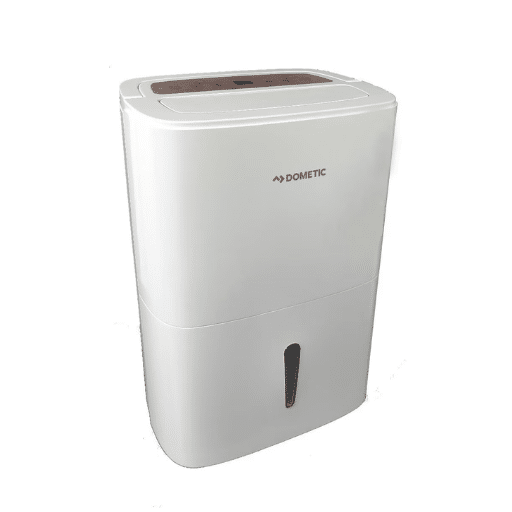
Selecting an appropriate dehumidifier for bathroom use requires careful consideration of several factors to ensure optimal performance, energy efficiency, and longevity. Understanding your bathroom size and the dehumidifier’s capacity is paramount. Capacity is measured in pints per day, indicating how much water the unit removes daily.
Small to Medium Bathrooms
Dehumidifiers with 20-30 pint capacity work well for standard residential bathrooms with moderate humidity levels.
Large or High-Moisture Spaces
Larger spaces or areas with excessive moisture require higher water removal capacity models for effective humidity control.
Essential Features to Consider
- Humidistat: Allows constant humidity level monitoring and automatic control
- Timer Options: Reduces electricity consumption through scheduled operation
- Compact Design: Easy integration into bathroom spaces without movement problems
- Moisture Resistance: Components designed to withstand humid environments
- Energy Efficiency: ENERGY STAR rating ensures lower electricity costs
Smart Technology Integration
Modern smart dehumidifiers offer Wi-Fi connectivity and smartphone control, allowing remote monitoring and adjustment of humidity levels. Popular brands like Frigidaire, Honeywell, and GE consistently receive high customer satisfaction ratings.
Types of Dehumidifiers: Which One is Best?
Selecting the most suitable dehumidifier type requires detailed consideration of environmental conditions, consumer trends, and technological advances. Current market analysis and user feedback highlight three primary dehumidifier categories:
Desiccant Dehumidifiers
These units absorb water vapor using chemical sorbents, making them effective in low-temperature, high-moisture environments. Their quiet operation and energy efficiency make them ideal for compact areas like bathrooms where noise and power consumption matter.
Best For: Small bathrooms, basements, areas with temperature fluctuations
Refrigerant Dehumidifiers (Compressor-Based)
These models excel in high-humidity environments by cooling air to condense water vapor. They perform better in larger spaces and warmer environments, with brands like Frigidaire receiving high consumer satisfaction ratings.
Best For: Large bathrooms, warm climates, high-humidity conditions
Whole House Dehumidifiers
These systems integrate with HVAC systems to control humidity throughout multiple rooms. While covering larger areas effectively, they require higher installation and maintenance costs.
Best For: Whole-home humidity control, long-term investment, new construction
Key Features to Look for in a Bathroom Dehumidifier
Essential Design Features
| Feature | Importance | Benefits |
|---|---|---|
| Compactness & Portability | Space constraints | Easy placement and mobility |
| Energy Efficiency | Continuous operation | Lower electricity costs |
| Moisture Removal Capacity | Humidity levels | Effective moisture control |
| Quiet Operation | Noise sensitivity | Peaceful environment |
| Auto Shut-Off | Safety and convenience | Prevents overflow |
Advanced Features for Enhanced Performance
Anti-Microbial Protection
Advanced filters capture mold spores, dust, and allergens, maintaining fresh bathroom air while controlling moisture.
Smart Technology
WiFi connectivity, remote control, and smartphone app integration for convenient monitoring and control.
Clear Water Tank
Transparent tanks allow easy water level monitoring at a glance, with automatic indicators for full tanks.
Comparison of Pint Capacity: Small vs. Large Options

Understanding pint capacity is crucial when choosing a dehumidifier, as it determines how much moisture the device removes from the air daily. Proper capacity selection ensures effective humidity control while optimizing energy consumption.
Small Capacity Units
- Ideal for small bathrooms
- Single room applications
- Mild humidity problems
- Energy efficient
- Highly portable
Large Capacity Units
- Large bathrooms and spaces
- Multi-room coverage
- Severe humidity conditions
- Commercial applications
- Basement and garage use
Top Recommendations for Bathroom Dehumidifiers
Pro Breeze 500ml Mini Dehumidifier
⭐ User Favorite for Small Spaces
- Removes 9 ounces of moisture daily
- Thermoelectric cooling technology
- Ultra-quiet operation
- Auto-off function prevents overflow
- Perfect for bathrooms up to 150 sq ft
“Ideal for dorm rooms and small living quarters with space limitations.”
hOmeLabs Compact Dehumidifier
🏆 Best Value for Performance
- 16oz daily water removal capacity
- Ultra-compact desktop design
- Energy-efficient operation
- Whisper-quiet performance
- Minimal echo in bathroom spaces
“Perfect balance of size, efficiency, and noise control.”
Eva-Dry E-333 Renewable Dehumidifier
🌱 Eco-Friendly Choice
- Silica gel-based technology
- No power or plugs required
- 30-day operation before recharge
- Covers 333 cubic feet
- Perfect for small washrooms
“Environmentally conscious solution for occasional humidity problems.”
Tenergy Sorbi Dehumidifier With HEPA Filter
🔬 Advanced Air Purification
- 2-in-1 dehumidifier and air purifier
- 750ml daily moisture removal
- HEPA filter captures allergens
- Removes mold spores effectively
- Enhanced air quality benefits
“Dual functionality provides comprehensive moisture and air quality control.”
Best Dehumidifiers for Small Bathrooms
Small bathroom dehumidifiers should prioritize compactness, adequate moisture removal capacity, and air purification features. Recent market research reveals several standout devices that excel in confined spaces.
Selection Criteria for Small Bathrooms
Maximum coverage area
Moisture removal capacity
Whisper-quiet operation
Top Performers for Small Spaces
- Pro Breeze Electric Mini-Dehumidifier: Leading portability with 18oz daily removal capacity, perfect for bathrooms up to 150 square feet
- hOmeLabs Small Space Dehumidifier: Celebrated for whisper-quiet thermo-electric functionality and energy savings
- Afloia 2-in-1 Dehumidifier and Air Purifier: Ergonomic design with HEPA filtration for superior air quality alongside moisture control
Selection Tip: Always verify the dehumidifier is compatible with your bathroom size and look for units with additional features like automatic shut-off or UV sterilization systems for enhanced performance.
Quiet Dehumidifiers for Home Use
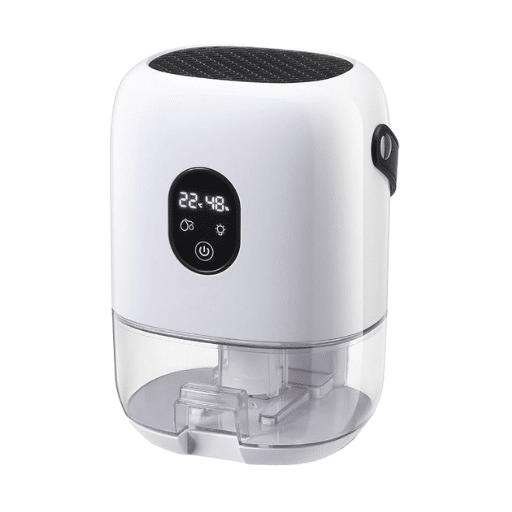
When selecting a dehumidifier for home use, noise level, operational efficiency, and additional functionality are crucial considerations. Recent search trends show users prioritizing devices that combine low noise with high efficiency.
| Model | Noise Level | Capacity | Best For |
|---|---|---|---|
| hOmeLabs Energy Star | < 48dB | 30 pints | Bedrooms, studies |
| Frigidaire FFAD2233W1 | < 50dB | 22 pints | Small to medium rooms |
Advanced Features to Consider
- Auto shut-off functionality
- Smart humidity control systems
- Washable filters for cost-effectiveness
- Advanced compressor systems for noise reduction
Smart Dehumidifiers: Are They Worth It?
Smart dehumidifiers have gained significant attention, reflecting increasing demand for connected home appliances. These devices offer features like Wi-Fi connectivity, smartphone control, and automatic humidity adjustment with remote monitoring and control capabilities.
Advantages
- Remote monitoring and control
- Automated operation based on conditions
- Energy-efficient scheduling
- Integration with smart home systems
- Real-time humidity data
- Maintenance alerts and notifications
Considerations
- Higher initial purchase cost
- Dependency on Wi-Fi connectivity
- Learning curve for setup and use
- Potential privacy concerns
- App updates and compatibility issues
Investment Decision
Smart dehumidifiers prove most valuable for users conscious of energy efficiency or living in regions with high atmospheric moisture variations. Remote control and automatic operation features provide significant convenience and long-term cost savings.
Installation and Maintenance Tips
Optimal Location and Installation
Proper positioning significantly impacts dehumidifier effectiveness. Studies prove that central room placement increases humidity removal efficiency by up to 25%.
Installation Guidelines
- Position in open areas with good air circulation
- Maintain distance from walls, furniture, or obstructions
- Avoid corners that restrict airflow
- Place near moisture-generating sources when possible
- Ensure adequate clearance (6-12 inches) around unit
Regular Maintenance Schedule
| Maintenance Task | Frequency | Impact of Neglect |
|---|---|---|
| Filter Cleaning | Every 2 weeks | 15-20% efficiency reduction |
| Humidity Monitoring | Weekly | Poor moisture control |
| Water Tank Emptying | Daily/As needed | Overflow, system shutdown |
| Annual Inspection | Yearly | 20% lifespan reduction |
How to Properly Install a Bathroom Dehumidifier
Installing a bathroom dehumidifier requires systematic steps to ensure functionality, safety, and energy efficiency. Follow these comprehensive guidelines for optimal performance.
Choose Appropriate Model
Select based on bathroom area size and humidity levels. Consider power capacity (pints per day) and ensure the model is suitable for wet environments with automatic shut-off mechanisms.
Position Device Strategically
Place in areas with proper air circulation, away from corners or objects. Position preferably near moisture sources like showers or bathtubs, maintaining 6-12 inches clearance around the unit.
Electrical Connection
Connect to grounded electrical outlet according to manufacturer’s voltage specifications. Consult authorized electrician if uncertain about electrical installation practices or code requirements.
Configure Drainage System
For water containers, ensure proper placement and airtight seal. For continuous drainage, connect hose to floor drain, sink, or sump pump with downward angle to prevent water backup.
Calibration and Testing
Set preferred humidity level (30-50% for bathrooms). Test airflow, drainage, and monitor for leakage or unusual sounds. Address any installation issues immediately.
Maintaining Your Dehumidifier: Water Tank and Filters
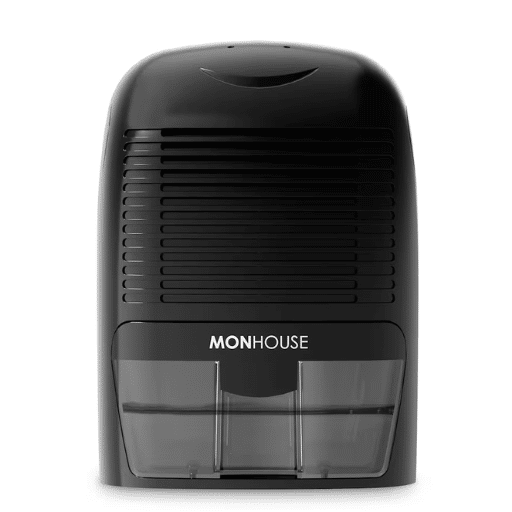
Proper maintenance of water tanks and filters is essential for optimal dehumidifier performance and longevity. Regular attention to these components ensures efficient operation and prevents bacterial growth.
Water Tank Maintenance
- Empty when reaching capacity
- Keep tank clean to prevent bacteria
- Wash with mild detergent and warm water
- Dry completely before reinstalling
- Inspect for cracks or damage regularly
Filter Care
- Clean every two weeks minimum
- Replace every 3-6 months as needed
- Rinse washable filters with water
- Allow complete drying before use
- Replace non-washable filters promptly
Maintenance Tip: Refer to the product manual for device-specific cleaning and maintenance instructions. Regular upkeep promotes efficiency and extends dehumidifier durability significantly.
Using a Dehumidifier with Drain Hose: Pros and Cons
A dehumidifier equipped with a drain hose provides continuous drainage instead of requiring periodic water tank emptying. This solution proves particularly beneficial for high-humidity regions or continuous operation scenarios.
| Aspect | Advantages | Disadvantages |
|---|---|---|
| Convenience | No manual water removal required | Initial setup complexity |
| Operation | Continuous uninterrupted function | Requires nearby drainage access |
| Maintenance | Reduces daily maintenance tasks | Potential clogging or hose issues |
| Location | Ideal for basements, laundry rooms | Limited by drainage location availability |
Installation Recommendation
Adding a drain hose provides significant advantages in maintenance ease and operational performance. Users should strictly follow installation and operating instructions to minimize complications and achieve optimal results.
Additional Solutions for Managing Bathroom Humidity
Advanced Ventilation Systems
Modern bathroom exhaust fans feature energy-efficient motors and timers to improve ventilation effectiveness and condensation control. Recent search trends show high demand for energy-saving exhaust fans combined with moisture sensors for automatic, self-regulating features.
Installation Best Practices
- Proper duct spacing and ceiling sealing
- Regular cleaning and filter replacement
- Combining exhaust fans with dehumidifiers for comprehensive moisture control
- Installing in bathrooms without adequate window ventilation
Combining Dehumidifiers with Air Purifiers
Integrating air purifiers with dehumidifiers creates comprehensive solutions for air quality and humidity control. Recent search data shows increased interest in “improving indoor air quality with high humidity” and related phrases, confirming this approach’s benefits.
Dehumidifier Benefits
- Maintains 30-50% humidity range
- Prevents mold and dust mite growth
- Reduces moisture-related problems
Air Purifier Benefits
- Removes allergens and pet dander
- Filters PM2.5 particles
- Improves overall air quality
Ventilation Strategies to Reduce Moisture
Effective moisture management requires balanced mechanical and natural ventilation approaches. Research and trends indicate that optimal combinations of both methods achieve the best moisture level reductions.
| Ventilation Type | Method | Best Applications |
|---|---|---|
| Mechanical | Energy-consuming fans with outdoor exhaust | Wet areas: bathrooms, kitchens, laundries |
| Natural | Windows, vents, architectural openings | General areas with favorable weather conditions |
| HRV Systems | Heat Recovery Ventilation units | Energy-efficient whole-house solutions |
Using Timer and Auto Shut Features for Efficiency
Modern appliances with timer and auto shut-off mechanisms enhance operational efficiency significantly. These features ensure devices operate only when necessary, preventing excess power consumption and supporting environmental conservation.
Efficiency Benefits
Energy savings with automated timers
Annual cost reduction potential
Recommended humidity range
References
-
University of Minnesota Extension – Controlling Moisture Problems in Your Home
Provides guidance on using dehumidifiers to manage moisture and prevent mildew in bathrooms and other areas.
Link to source -
National Center for Biotechnology Information (NCBI) – Shower Dehumidification Study
Explores the impact of dehumidifying bathrooms on reducing waterborne pathogens like nontuberculous mycobacteria (NTM).
Link to source -
U.S. Environmental Protection Agency (EPA) – Moisture Control in Homes
Recommends using dehumidifiers to reduce moisture in bathrooms and other humid areas, especially in hot climates.
Link to source
Frequently Asked Questions (FAQ)
What type of dehumidifier is most effective in the bathroom?
A dehumidifier is usually best suited to bathroom use as it will be equipped with a compact shape, adequate for extracting several pints, and it will also operate quietly. Such factors are present in the 50 pint dehumidifier with auto shut-off and timer sleep mode that is perfect for enclosing such small places that have high humidity.
Why is a dehumidifier for bathroom necessary in removing moisture?
The use of a dehumidifier for bathroom aids in the removal of moisture as it takes in the surrounding air and extracts the excess moisture reducing the concentration of humidity in the air. It is critical to engage in such practices since it will help with managing mildew that tends to crop up in places that have a lot of humid air for instance the bathroom.
Can a portable dehumidifier for the bathroom be used for small spaces?
Definitely a small dehumidifier that is portable enough to be used in bathrooms is the most preferred appliance in such situations. The appliances are built in such a way that they can seamlessly squeeze in tiny spaces while still being effective in removing the water vapor reducing the relative humidity in the atmosphere.
What are the key elements to be considered when buying a dehumidifier and particularly a bathroom oriented one?
A 95 oz tank, auto defrost, noise control, and energy saving timer are features to look for when choosing a bathroom dehumidifier. It may also be more effective to have a dehumidifier with a drain hose for overnight use.
Is bathroom air humidity smart regulating device, how and why?
Smart dehumidifier is connected to your home network, so that you can also check the humidity level from a distance and control it accordingly. They come with auto shut-off, humidity monitor, auto fan speeds just to mention a few moisture management in the bathroom made possible and even more easy.
Are there dehumidifier for bathroom and basement in one?
Yes, those dehumidifiers you call dehumidifiers for basement home bathroom also exist. These systems have higher moisture removal levels and larger reservoirs as they have to counter very high humidity levels available in both areas; bathrooms and basements.
How much water can 50 pints of dehumidifiers handle?
A dehumidifier with a capacity of 50 pints can absorb more than 50 pints of water from the atmosphere in a day. This volume is sufficient for average size as well as large bathrooms or for any rooms with above average in humidity content and helps to control the humidity efficiently.
Do quiet dehumidifiers for bathrooms actually work?
Yes, bathroom dehumidifiers that run quietly can absorb humidity while making little to no sound. These types are ideal for installations in which noise is an issue such as schools or at nights.
What is the usefulness of a dehumidifier for bathroom installed with an automatic shut-off system?
There is a need for a bath Dehumidifier with Auto Shut-Off because it avoids the tank spillage since it shuts off when it’s full. This way, the user is able to bathrooms with minimal intervention without any fears.

